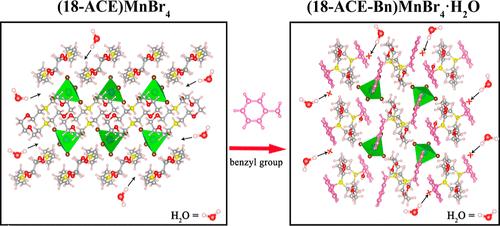当前位置:
X-MOL 学术
›
Inorg. Chem.
›
论文详情
Our official English website, www.x-mol.net, welcomes your
feedback! (Note: you will need to create a separate account there.)
Precise Modification of Organic Cations to Enhance the Moisture Stability and Luminescence Efficiency of Mn-Based Halides
Inorganic Chemistry ( IF 4.3 ) Pub Date : 2024-11-19 , DOI: 10.1021/acs.inorgchem.4c04030 Donghui You, Kailei Li, Yuanyuan Chang, Ruiqin Wang, Rongxing He, Lei Zhou, Ming Li
Inorganic Chemistry ( IF 4.3 ) Pub Date : 2024-11-19 , DOI: 10.1021/acs.inorgchem.4c04030 Donghui You, Kailei Li, Yuanyuan Chang, Ruiqin Wang, Rongxing He, Lei Zhou, Ming Li

|
Eco-friendly organic–inorganic hybrid metal halides (OIMHs) are widely recognized as promising candidates for next-generation semiconductor materials. However, achieving inherent moisture stability in OIMHs remains a significant challenge due to the highly hygroscopic nature of the halide structures. In response, a strategy to precisely modify the organic cation (18-ACE: 4,13-diaza-18-crown 6-ether) was developed by introducing hydrophobic benzyl groups into 18-ACE, forming a protective layer that enhances the moisture stability of the OIMHs. Specifically, benzyl groups were incorporated into 18-ACE to create 18-ACE-Bn, which was then used as an organic component to construct zero-dimensional Mn-based (18-ACE)MnBr4 and (18-ACE-Bn)MnBr4·H2O, exhibiting photoluminescence quantum yields (PLQYs) of 68.18% and 97.17%, respectively. Notably, (18-ACE-Bn)MnBr4·H2O demonstrates exceptional moisture stability compared to (18-ACE)MnBr4, retaining 97% of its initial PLQY even after 180 days of exposure to 70% relative humidity. Molecular dynamics and density functional theory calculations indicate that this superior stability is attributed to the terminal benzyl groups embedded within the inorganic framework, forming a compact structure with abundant weak interactions. Leveraging the unique spectral characteristics of (18-ACE-Bn)MnBr4·H2O, a high-performance WLED with a wide color gamut of 125.2% NTSC (National Television Standard Committee) was developed, highlighting its potential for backlight display applications.
中文翻译:

有机阳离子的精确改性,以提高 Mn 基卤化物的水分稳定性和发光效率
环保的有机-无机杂化金属卤化物 (OIMH) 被广泛认为是下一代半导体材料的有前途的候选材料。然而,由于卤化物结构的高度吸湿性,在 OIM 中实现固有的水分稳定性仍然是一项重大挑战。作为回应,通过将疏水性苄基引入 18-ACE 中,开发了一种精确修饰有机阳离子(18-ACE:4,13-二氮杂-18-冠 6-醚)的策略,形成增强 OIMH 水分稳定性的保护层。具体来说,将苄基掺入 18-ACE 中生成 18-ACE-Bn,然后将其用作有机组分构建零维 Mn 基 (18-ACE)MnBr4 和 (18-ACE-Bn)MnBr4·H2O,光致发光量子产率 (PLQY) 分别为 68.18% 和 97.17%。值得注意的是,(18-ACE-Bn)MnBr4·与 (18-ACE)MnBr4 相比,H2O 表现出卓越的水分稳定性,即使在 70% 相对湿度下暴露 180 天后,仍能保持 97% 的初始 PLQY。分子动力学和密度泛函理论计算表明,这种卓越的稳定性归因于嵌入无机框架内的末端苄基,形成具有丰富弱相互作用的致密结构。利用 (18-ACE-Bn)MnBr4·H2O 是一款高性能 WLED,具有 125.2% NTSC(美国国家电视标准委员会)的宽色域,凸显了其在背光显示应用方面的潜力。
更新日期:2024-11-20
中文翻译:

有机阳离子的精确改性,以提高 Mn 基卤化物的水分稳定性和发光效率
环保的有机-无机杂化金属卤化物 (OIMH) 被广泛认为是下一代半导体材料的有前途的候选材料。然而,由于卤化物结构的高度吸湿性,在 OIM 中实现固有的水分稳定性仍然是一项重大挑战。作为回应,通过将疏水性苄基引入 18-ACE 中,开发了一种精确修饰有机阳离子(18-ACE:4,13-二氮杂-18-冠 6-醚)的策略,形成增强 OIMH 水分稳定性的保护层。具体来说,将苄基掺入 18-ACE 中生成 18-ACE-Bn,然后将其用作有机组分构建零维 Mn 基 (18-ACE)MnBr4 和 (18-ACE-Bn)MnBr4·H2O,光致发光量子产率 (PLQY) 分别为 68.18% 和 97.17%。值得注意的是,(18-ACE-Bn)MnBr4·与 (18-ACE)MnBr4 相比,H2O 表现出卓越的水分稳定性,即使在 70% 相对湿度下暴露 180 天后,仍能保持 97% 的初始 PLQY。分子动力学和密度泛函理论计算表明,这种卓越的稳定性归因于嵌入无机框架内的末端苄基,形成具有丰富弱相互作用的致密结构。利用 (18-ACE-Bn)MnBr4·H2O 是一款高性能 WLED,具有 125.2% NTSC(美国国家电视标准委员会)的宽色域,凸显了其在背光显示应用方面的潜力。


















































 京公网安备 11010802027423号
京公网安备 11010802027423号